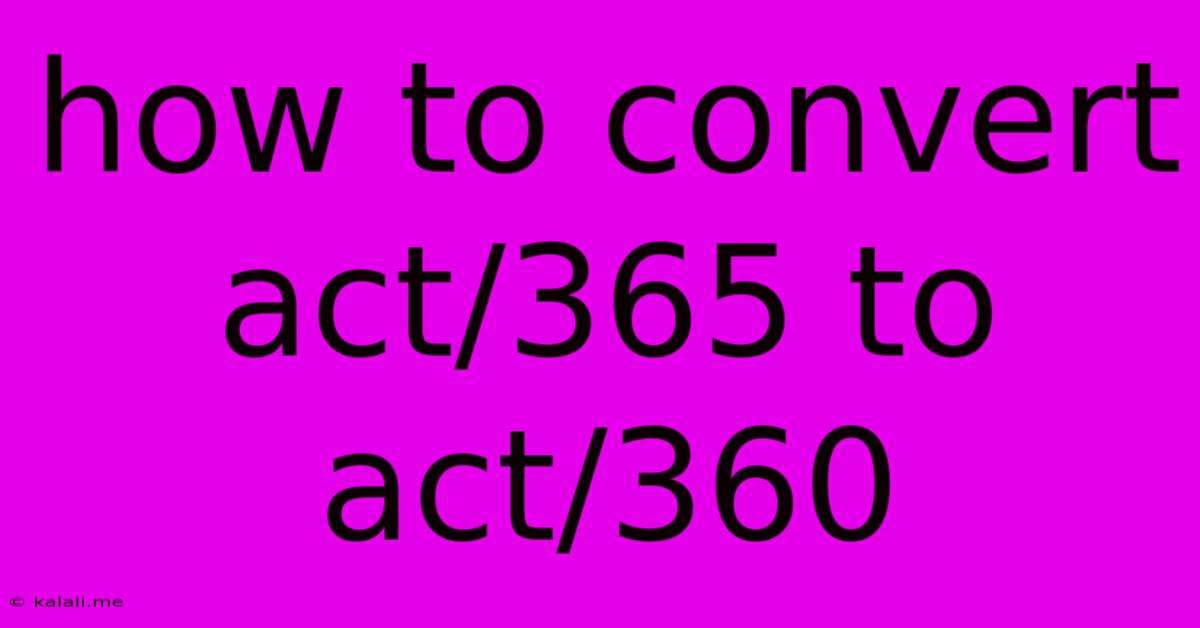How To Convert Act/365 To Act/360
Kalali
Jun 06, 2025 · 3 min read

Table of Contents
How to Convert ACT/365 to ACT/360: A Comprehensive Guide
Meta Description: Learn how to accurately convert interest calculations from an actual/365 day-count convention to an actual/360 day-count convention. This guide explains the process, provides examples, and highlights the implications of this conversion.
Accurate interest calculations are crucial in finance, and the day-count convention used significantly impacts the final result. Two common conventions are ACT/365 (Actual/365) and ACT/360 (Actual/360). Understanding how to convert between them is essential for various financial applications, ensuring consistency and avoiding errors. This article will guide you through the conversion process, offering clarity and practical examples.
Understanding ACT/365 and ACT/360
Before diving into the conversion, let's clarify the meaning of these conventions:
-
ACT/365 (Actual/365): This convention uses the actual number of days in the period divided by 365 (or 366 for leap years). It's considered more precise as it accounts for the actual length of the year.
-
ACT/360 (Actual/360): This convention uses the actual number of days in the period, but always divides by 360, regardless of whether it's a leap year. It simplifies calculations but introduces a slight inaccuracy.
The choice between these conventions depends on the specific financial instrument and agreement. Sometimes, conversions are necessary for comparison or reconciliation purposes.
The Conversion Formula
There isn't a single direct formula to convert an interest calculation from ACT/365 to ACT/360. The conversion depends on the initial interest calculation under the ACT/365 convention. The core concept involves recalculating the interest using the ACT/360 convention.
Let's break it down:
-
Identify the Key Variables: You'll need the principal amount (P), the annual interest rate (r), and the actual number of days (n) in the period for which the interest is calculated.
-
Calculate Interest under ACT/365: First, calculate the interest using the ACT/365 convention:
Interest_ACT/365 = P * r * (n/365)(or n/366 for leap years) -
Recalculate Interest under ACT/360: Now, using the same principal, rate, and actual number of days, recalculate the interest using the ACT/360 convention:
Interest_ACT/360 = P * r * (n/360)
This gives you the equivalent interest under the ACT/360 convention.
Practical Example
Let's say you have a principal amount of $10,000, an annual interest rate of 5%, and the interest period is from January 15th to March 15th (60 days).
-
ACT/365 Calculation:
Interest_ACT/365 = 10000 * 0.05 * (60/365) ≈ $82.19 -
ACT/360 Calculation:
Interest_ACT/360 = 10000 * 0.05 * (60/360) = $83.33
As you can see, there's a difference of approximately $1.14 between the two calculations. This difference is due to the differing denominators in the formulas.
Implications and Considerations
The difference between ACT/365 and ACT/360 calculations might seem small, but it can accumulate significantly over time or with larger principal amounts. This difference is especially noticeable in longer-term instruments. It's crucial to understand the implications, particularly when comparing interest calculations from different sources using different conventions.
Always ensure you understand which day-count convention is being used when dealing with financial instruments and calculations. Clearly specify the convention used in any financial reporting or documentation to avoid misunderstandings and potential disputes. Understanding the conversion process ensures accuracy and consistency in your financial work.
Latest Posts
Latest Posts
-
Expectation Of Product Of Dependent Random Variables
Jun 06, 2025
-
Ac Exhaust Hose With Window Screen
Jun 06, 2025
-
How Do You Say At All In Spanish
Jun 06, 2025
-
Why Does Acceleration Of A Car Decrease When Speed Increases
Jun 06, 2025
-
Blender How To Turn Mirror To Object
Jun 06, 2025
Related Post
Thank you for visiting our website which covers about How To Convert Act/365 To Act/360 . We hope the information provided has been useful to you. Feel free to contact us if you have any questions or need further assistance. See you next time and don't miss to bookmark.